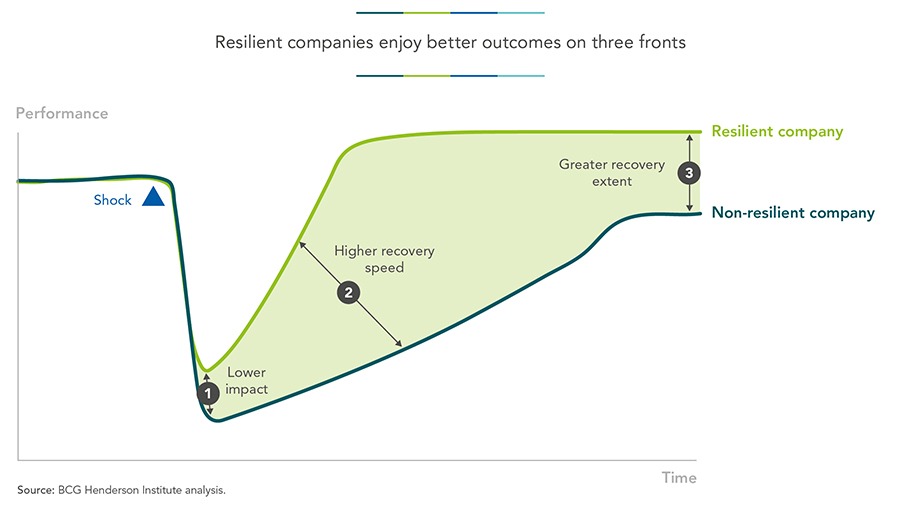Resilience has been a buzzword in many boardrooms, earning the distinction of being named Forbes Magazine’s Word-of-the-Year for 2021 and even Word of the Decade by some.
The definition from the British Standard Code of Practice for Organisational Resilience says:
Resilience: /rɪˈzɪl.jəns/ (noun) “the ability of an organisation to anticipate, prepare for, and adapt to incremental change and sudden disruptions in order to survive and prosper.”*
But what exactly does it mean? What are the component parts, and how do you know you have it?
Resilience has strategic value: it leads to better performance. Boston Consulting Group (BCG) found that resilient businesses outperform their industry average by nearly 30% during unfavourable periods. Crisis periods had a bigger impact on out-performance than stable periods, with recovery speed and extent of recovery being important factors.
Building resilience is important for businesses to prepare for disruptions and take advantage of opportunities. However, implementing an effective Resilience Programme can be challenging due to conflicting priorities, skills challenges, resources, and budget constraints.
At Redcentric we see that resilience combines both elements of resistance and readiness, as we all understand that prevention is better than the cure. Investing in resilience gives you a competitive edge by allowing you to adapt quicker than others to changing circumstances. Increasing your resilience generates confidence amongst staff and customers. It also ensures you meet the expectations of regulators and investors.
Resilient companies enjoy better outcomes on three fronts:
Measuring resilience and quantifying what this means for any organisation can be confusing. There are many different elements of business resilience to consider. To support you we have identified the seven elements of resilience as key components of overall business resilience:
Governance
You need to be clear who has overall oversight, who is responsible for what and who will take decisions in the event of a disaster.
Governance is a framework of oversight and accountability which ensures structures, systems and practices support effective decision-making and ongoing management of your resilience programme.
Risk Management
Do you know what poses the greatest risk in your organisation and what to tackle first in the event of a disaster?
Risk management is the identification, evaluation, and prioritisation of risks followed by a coordinated response to ensure you maximise resources in the event of a disaster and minimise impact.
Business Continuity
You will need to know and be clear about the critical operations that need to be restored following a disaster. Then you need to have the decision-making processes, capabilities and experience to respond in the event of a disaster?
Business continuity planning allows an organisation to continue the delivery of products or services at pre-defined acceptable levels following a disruptive incident and this includes an understanding of interdependencies when it comes to restoring systems.
IT Service Continuity
Can you prevent disruption and recover your IT services effectively?
This is the capability of an organisation to support its business operations by prevention, detection and response to disruption and recovery of IT services.
Security Testing
Are your recovery capabilities and protective solutions tried and tested?
To be able to recover IT services you need multiple capabilities which begin with planning to protect, to detect and then respond and recover, and you need to determine whether they will work as planned by performing regular testing to ensure they achieve the desired outcome in the event of a disaster.
Monitoring and Detection
How quickly would you be able to identify a threat?
You need to be searching for possible opportunities and potential threats, so that you are able to recognise signals of impending problems and how they might manifest themselves across the business.
Incident Response and Crisis Management
Would your staff who are normally focused on the day-to-day operations have the knowledge and experience of how to restore systems in the event of a disaster?
You need to have the knowledge, skills and familiarity with how to respond to an incident in a planned, coherent manner and be able to deal with issues that may represent an existential threat to the business.
With the seven elements of resilience in place, your business will be one step ahead of your competition, confident in the knowledge that you have the key components of business continuity and security in place.
This then allows you to respond rapidly to new business opportunities and changes in the market; to grow and scale up operations smoothly and to take on staff and expand into new regions.
If you are unsure about your organisation’s resiliency posture, our dedicated team of resilience experts can help review your estate and provide understanding of where your risks lie with Redcentric’s resilience MOT. Get in touch with us today.




